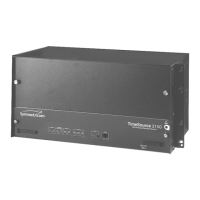Chapter 4 TL1 Reference
Parameters
98 TimeSource User’s Guide 097-72020-01 Revision K – December 2005
<pid> Private identifier, factory-set to “TS3000!!”. It is the initial password for the
TELECOM <uid>. Passwords are encrypted when stored in the TimeSource
3100, and are never transmitted from the shelf. The pid contains a
case-insensitive string of 8 to 10 ASCII characters, and must include at least
one letter, one numeral, and one special character from the following:
! @ $ % * ( ) + ’ ? / ‘ <
<sid> Source identifier which is the name of the equipment sending the message.
The sid may be an identifier or text string, and may begin with a letter. A
maximum of 20 characters (limited to letters, digits, and hyphens) are
allowed. The sid is recommended to be the equipment's CLLI code.
<spec_block> Replaced by a number of parameters within the command. Parameters are in
the format <name>=<value>, may be entered in any order, and must be
separated by a comma.
<srveff> Identifies whether the alarm condition is service affecting:
SA = service affecting
NSA = not service affecting
<tid> Target identifier which identifies the equipment (TimeSource 3100) to which
the command is directed. The tid must be a valid TL1 identifier of a maximum
of 20 characters (limited to letters, digits, and hyphens) beginning with a
letter. The <tid> is recommended to be the target's CLLI code, but it can be
null if the OS directly interfaces to the target. The <tid> can be omitted only if
connection is made directly to a single TimeSource 3100 Shelf.
<time> Current time in the six-digit form: hh-mm-ss (command) or hh:mm:ss
(response or message), where hh is hours (00 to 23), mm is minutes (00 to
59), and ss is seconds (00 to 59). For example, 5:11:49 a.m. is 05:11:49.
<uap> User access level, used by a system administrator to assign a given level of
access to system users. User access level ranges from 1 to 5, with 1 being
the lowest access level, and 5 being the highest access level.
<uid> User identifier, factory-set to TELECOM. The <uid> contains alphanumeric,
case-insensitive strings of 6 to 10 characters provisioned as valid login IDs.
<uout> User inactivity password which indicates the number of days a system user
has not logged on to the system. The user inactivity time-out range is 0 to
180 days, with 0 indicating no time-out.
<vldty> Validity of the performance monitoring data.
Table 4-1. Parameter Definitions (Continued)

